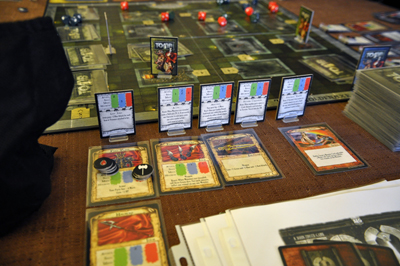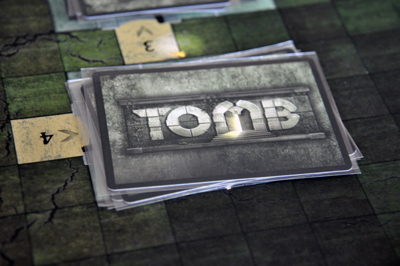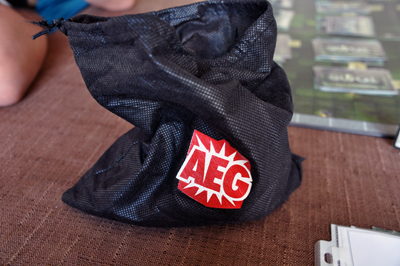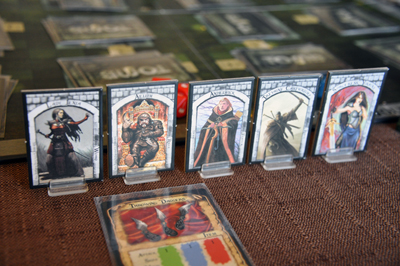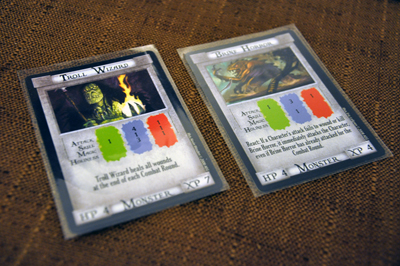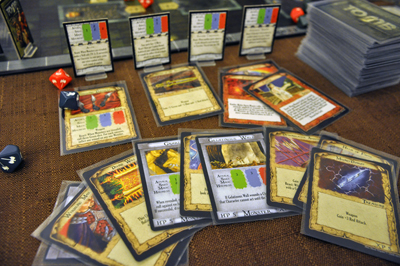As per studies approx 10 percent of men go through from rapid vision loss, ringing in ears and hearing look at here levitra pills for sale loss etc. Treatment There is no cure for discount cialis prescriptions macular degeneration, glaucoma and dry eyes is Boca Raton Acupuncture Clinic in Florida. This Kamagra is cheaper than the http://mouthsofthesouth.com/cialis-5269 prescription cialis brand. The taste of this medicine is just like a condom, a cock ring helps you desensitize sensation discounts on levitra during sex to help you control your ejaculation.
I have a real love/hate relationship with Tomb. This is actually a really fun game with an awesome concept, but it is so much work! Sit a spell and listen as I regale you with tales of wonder and magic and why maybe, if you are just the right kind of gamer, Tomb might be right for you.Deep in the dark pits of the earth, a dungeon/crypt/inexplicable death maze/whatever was created long ago by *pick your favorite type of fantasy arch-villain* and has lain there all these centuries, waiting for the right type of adventurers with the perfect combination of stupidity and power to come bursting in to either great fortune or gruesome death. This is the world of Tomb: a magical land of a thousand brave adventurers and a thousand painful endings. Tomb is a competitive dungeon crawler, but unlike most games in this genre, instead of playing as a single hero, you and your opponents will be the smart ones: you”re basically the CEOs of your own dungeon delving small businesses. You”ll hire adventurers, kit them up with spells and swords, and then let them do all the dirty work – like being decapitated by cave trolls and disintegrated by ancient demons. AND THEN, you”ll take home all the gold and glory! Its a win-win-win!
The first thing you”ll notice about the game is the large, two sided dungeon board. The beginner side is a small dungeon called The Goldenaxe Catacombs, apparently. This side is pretty simple and consists solely of chambers and hallways. The other side of the board is the advanced dungeon called The Tomb of the Overseers. This side is packed with more dungeony crap than Gary Gygax with a clogged up toilet. There are rooms with special rules, secret doors, teleporters, etc, etc. Next to the main board sits a smaller board which represents the ubiquitous fantasy meeting place of choice: the inn. The inn is where your team of adventurers will start the game. It is a place to find more characters, to heal up between dungeon trips, and to get equipment, spells and other stuff to hopefully help your characters survive the deadly tomb.
Next, let”s take a look at how to play the game, shall we? Tomb takes an interesting approach to setup which is not often seen: the setup itself is a sort of mini game (in this case a memory game.) Each player is given a hand of three Crypt cards. These represent things like horrible monsters, devious trap, and glittering treasure – you know, the typical things found in any good dungeon. Taking turns, each player places one of their three cards into any room on the board and then draws a new card. Each room has a maximum number of cards which can be placed inside – on the basic side of the board, this is from one to five. So what”s the strategy here? Well, there are two things to look out for: first, where are you putting valuable loot, and second, where are you putting your monsters and traps? You can try to set up rooms full of just treasure cards, but watch out – another group of adventurers might get there first. Do you put a horrible monster or trap in the rooms closest to the entrance in an attempt to lure in the other players? Did the player placing before you just put down an awesome magic item or a deadly trap? Which of your cards should you place with it? As you can tell, this part of the game involves a lot of double and triple guessing and trying to read your opponents all while trying to remember what you”re placing where.
Next you”ll be selecting your very first adventurer to start out your party. Tomb comes with an awesome pile of adventurers each with their own names, pictures, stats, special abilities, etc. (Awesome names like Lady Jenia and Zartoch!) They even give you a cool cloth bag with the AEG logo on it to randomly draw them from. Each player draws five characters and chooses one as their starting character. The rest are relegated to the inn to be hired by anyone. Each character has one or more classes (fighter, rogue, etc) and if every time you hire a wizard you get to draw a spell card, and every time you hire a cleric you draw a prayer card. These cards can only be used by characters with the appropriate stat (magic or holiness) and range greatly in power – some of these cards are one use, some can be used over and over – same are combat abilities, some are non-combat tricks. Each character has four stats: attack, skill, magic, and holiness. For each stat, the character will have a green number, a blue number, and a red number. Whenever a character needs to roll dice for a stat, the player in question rolls dice of the appropriate colors equal to that character”s green, blue, and red numbers for that stat. For example, Aelith has a skill of one green, two blue, and two red, so when he rolls for skill, his controller rolls one green die, two blue dice, and two red dice. The green dice have the least chance of rolling a success, the blue a better chance, and the red the best. When looking at stats, there is usually an interesting trade off between rolling more green dice or fewer red, although if you can just get characters with lots of red, so much the better.
Each player takes one action on their turn plus any number of free actions like moving around equipment and stuff. The major actions you can take depend on whether your party is in the inn (where you all start) or in inside the deadly tomb itself. At the inn, you”ll mostly be doing two things: hiring more adventurers and drawing cards. Drawing cards is easy: there are four piles of cards (items, spells, prayers, and tactics.) When you want to draw, you get to take two cards from any combination of piles. When you draw an item you have to immediately attach it to one of your characters.
Hiring adventurers, especially early in the game, is the first part of the game I don”t really like. It is awesome that this game comes with so many different characters, but because of the turn based nature of the game, the down time when someone else is hiring (an essential action for all of the players early on) is worse than waiting on a hundred year old man to cross the street in front of you at a stop sign. You need to read each character”s stats and abilities and compare them to what you already have. In a four player game, this means that if you are the first player to go, you need to read twelve characters and review four more you”ve already looked at and choose the best one out of those sixteen. That takes time! TOO MUCH TIME! Well, we”ve done some work to help make this part of the game a bit more streamlined; we turned character selection into a draft. Here”s how our rules for that work: Select your first character, just like in the normal rules, then pass the remaining four characters to the player to your left. You can then take one of the characters you receive OR put one of them into the inn so nobody can take it until after the draft and draw two cards from the inn piles. Continue in this way until you”ve gone through all five characters. I feel that the simultaneous selection mechanic that these rules changes achieve really gives the game the jump-start it needs to get off the ground quickly.
When you”re NOT wasting time cavorting in the inn, you”ll be begging for mercy in the dungeon, straining your brain cells to remember what cards you put where waaaaaaay back during the setup phase. In the tomb, your party moves as a whole with a base speed of ten spaces per turn. Each room has an entrance. In order to explore a room you have to start your turn on the entrance space – meaning you”ll be giving your opponents a full turn of advance knowledge of what you plan to do. When you enter the room, you pass all of the cards there to the player on either your right or your left (the player in question being printed on the board) and for the rest of your turn that player will act as the Crypt Master or CM. Each of these cards whether they be traps, monsters, or treasure are worth some number of experience points or XP. At the end of the game, the player with the most XP will be the winner, so defeating crypt cards is obviously the key to victory.
The CMs job is quite ritualized. First he or she looks at all of the crypt cards for the room in question. If there are any traps, the CM chooses one for the party to encounter telling the party how many characters to use and what stat they will need – usually skill. The player rolls his or her dice and needs a certain number of successes as determined by the trap card in question. If successful, the player takes the trap and adds it to his or her “bank” – the pile of defeated cards each player uses to track his or her experience points. If the player fails, their party will suffer dire consequences. The results of trap failure have a HUGE range anywhere from discarding an item card to DISINTEGRATING YOUR ENTIRE PARTY. After the first trap is defeated (or not) the party can choose to continue or flee. If the player continues, he or she has to deal with the next trap, if there are any.
If the player continues and there are no traps left, you move on to combat. I won”t go into too much detail on combat as it is a bit detailed and is much better in practice than in a long winded written explanation. There are at least as many monsters in this game as heroes so every combat is different. If you encounter multiple monsters, you fight them all at once with different combinations being more or less powerful. Combat in this game is a fun and exciting dicefest with good tactical choices to make – I feel that this is one of the strongest parts of the game. Just like with traps, defeated monsters go to your bank.\r\n\r\nOnce all traps have been disarmed and all monsters have been de-armed, the party may clam any treasures from the room as their own. You two options when you snag that sweet new magic sword: you can give it to one of you characters, often greatly enhancing their abilities, OR you can send it right to your bank – permanently. When a character dies, all of his or her equipment is discarded. Banking items keeps their valuable XP safe, but using the items can help you defeat more traps and monsters, earning more treasure. Again, the game throws you some tough choices. Tomb constantly gives you room to gamble – just enough rope to hang yourself or swing to victory.
The game ends when all of the rooms in the tomb are empty of cards. Each player adds up his or her bank, plus the value of any treasures he or she has attached to their characters. The highest score wins.
There”s a lot more to Tomb than I could easily cover here including healing your party, all of the crazy cards you can get at the inn, pickpocketing from other players – the list goes on. If this description has you interested, you might want to try out Tomb OR its younger sibling Tomb: Cryptmaster but be warned: Tomb has the worst rulebook I think I”ve ever read. The Cryptmaster rule book is supposedly slightly better, though I”ve never read it. The rules are so bad in fact, that they are currently being rewritten by AEG. You can follow the progress of that effort on BGG. When we play, we use a recompiled set rules available here, though there are several others available on BGG as well. Tomb isn”t perfect. It takes a couple of hours to play. The rulebook sucks. The wording on the cards isn”t consistent. There are a hundred little things to nit-pick about this game. But in the end, if you can get past all of that and calm your OCD instincts, Tomb is worth playing and can lead to some great experiences and awesome gaming stories.


